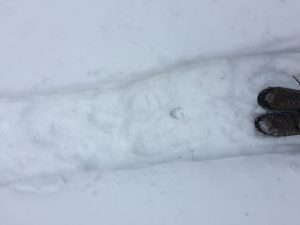
(Palmer, 2017)
Over my Thanksgiving break last semester, I returned home to Pepperell MA. During my visit, I chose to go to our town park to try to learn from the ecosystem there. As a teenager, my friends and I picnicked, played games, and stargazed there whenever the weather permitted. My connection to this place, on a human scale was already strong. I hoped by choosing it for my phenology blog assignment, that connection would grow, strengthen.
Naturally, I chose this place again for my spring break phenology assignment.
Upon my return I was excited to experience this place again, in an entirely new light, covered in a heavy blanket of snow. On Tuesday, New England quieted. Silenced by the oncoming blizzard, people holed up inside their homes. I waited until Sunday to visit, hoping to find some recent wildlife activity.
Along with my mom and dog, Ellie, I ventured back into the orchard, and my oh my did it look different. Clouds filled the sky and the temperature dipped into freezing. One thing that clearly remained the same was the birds.
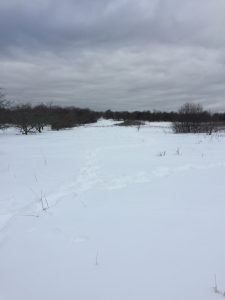
(Palmer, 2017)
I was amazed by the reaction as I entered their world. Immediately I recognized a few calls, the chickadees and crows. As I described in my last blog about the Pepperell Orchards, “Heald Street Orchards “, the land used to be a part of someone’s farm. Eventually the farm was abandoned and the orchards were left to the town. Today, the apple trees remain as a town park and sanctuary for birds and humans alike.
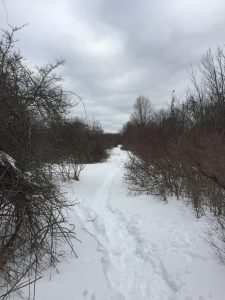
(Palmer, 2017)
Technically the day I visited was nearly spring, yet it felt more like winter in February. As I walked around I fell behind my mom and Ellie, finding space to listen and observe. As I took in this place I felt a comfort of home that is only starting to emerge at Salmon Hole. These trees know me. The air knows me. The birds and even the freshly fallen snow, know me. It often bothers me when that I am now hyperaware of how little I know about the beings in Burlington. It bothers me that I don’t know the names of the trees, or the songs of the birds. Then I go to the orchards. I still look around, and I couldn’t tell you the names of the shrubs that grow alongside the apple trees; I couldn’t tell you the names of the birds as they sing their songs. Even so, in my own way I know their names, there is a familiarity to their patterns, I feel a part of the landscape here. When I open my ears hear, I don’t hear the sounds of my own thoughts, but I sense the life of those around me.
The first place the orchards took me, was to the trail of one of my neighbors.
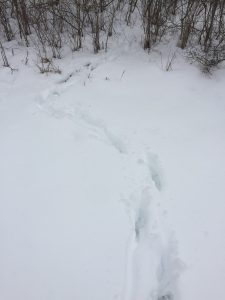
(Palmer, 2017)
After careful examination, my best guess for the name of this creature is deer. The size of the prints and direct register diagonal pattern pointed straight towards deer. I did not follow this trail, as the deer meandered off into the brush and woods. I stuck to the orchards.
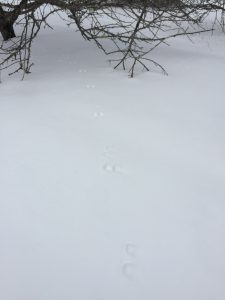
(Palmer, 2017)
After finding the deer, I observed another trail. It was smaller in size, lighter on the snow, with a galloper pattern. My best guess was that a squirrel had roamed through the area.
Then, my eyes came upon a wall of staghorn sumac. Birds were everywhere, darting from tree to tree. I stood and I listened, but was unable to recognize the call. Of course that only eliminated about two species. So there I stood, hoping that as I inched closer they would trust me enough to stay put. They did. Part of me believes it’s because this is my home too, and somehow they knew that.
I eventually came close enough to get a good look at the birds. There were robins everywhere the sumac were. For the first time I felt as though I had made a connection, I truly recognized a pattern on my own. Robins eat staghorn sumac, and there they were quite the group, chirping away on a sumac.
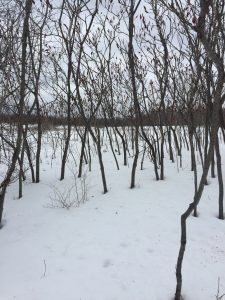
(Palmer, 2017) The only picture I was able to capture of the Robins in the Sumac, if you look closely you can see one between the trees, resting on the snow.
It’s amazing what comfort and familiarity will bring.
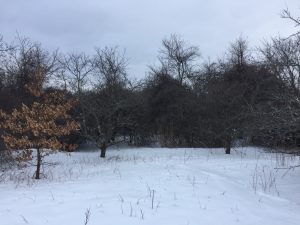
(Palmer, 2017)
As for the condition of the beloved trees, their phenological state remained that of winter. A distinct change from the last time I visited, but appropriate considering the recent blizzard.
One change in coniferous trees that elicited a deep sorrow in me, was that it seemed every where I went the trees has orange needles. The warming that occurred across New England in February took a toll, and there was nothing more evident on my journey home than the suffering orange needles. I even noticed that change on the forest edge that surrounds the orchards. It was not nearly as drastic as what I saw on the highways, but still discouraging.
It’s amazing what you notice when you open your eyes and listen to the world around you.
